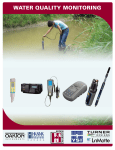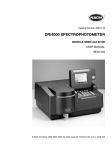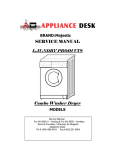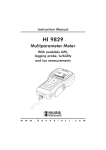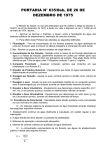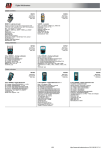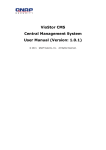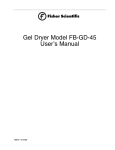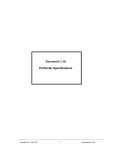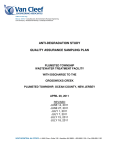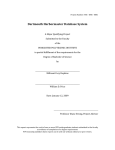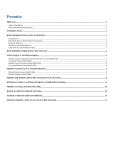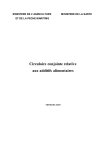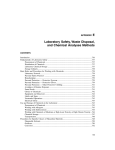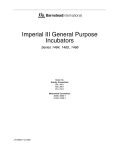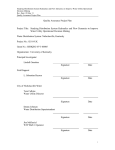Download INTRODUCTION - City of Devils Lake
Transcript
INTRODUCTION TERTIARY TREATMENT OF WASTEWATER BY LEMNA MINOR (DUCKWEED) John Hobbs Assistant Professor of Biology Lake Region State College Treatment of wastewater from city sewage systems has been a constant problem for years in terms of cost, storage structures, and method of treatment. During the 1960’s and into the 1970’s and 80’s, tougher environmental standards have put pressure on local communities and cities to find less expensive and more effective ways of wastewater treatment. Smaller towns and industries simply use a lagoon system as a way to deal with the wastewater. This type of system uses evaporation of the water that leaves the water chemical and waste products behind. Larger cities that generate millions of gallons of wastewater daily cannot depend entirely on evaporation and must discharge the excess wastewater into a river or lake. The primary problem is that the effluent must not contain waste nutrients or chemicals in excess of the EPA limits for the discharge to prevent contamination of the surrounding waterbodies. Devils Lake, North Dakota, has another unique problem that most cities do not have. The lake Devils Lake - is at the southern terminus of a 3600 square mile drainage basin from which there is no outlet. So the discharge of raw or untreated sewage into the lake could be detrimental to the shorelines, ecology and recreational fishing. As evidenced by studies made by Ecologists during the 1970’s, pollutant chemicals such as phosphates, nitrates, nitrites, ammonia, fecal bacteria, and other contaminants were being discharged from the city lagoon system as overflow and created some nasty conditions in certain areas of the lake. Several methods of treating the discharge of sewage water were studied during the latter 1980’s such as building an expensive chemical treatment plant, building a larger lagoon system, a cattail aquaculture which has proved only moderately successful. Another type of aquaculture for treating sewage water is the use of a small, floating plant called Lemna minor, or Small Duckweed. This is the plant that commonly grows on ponds, sloughs and around the edges of lakes all over the midwestern United States. In the early 1980’s, a young sculptor/civil engineer from the Twin Cities came up with the idea of using Lemna minor as an alternative method for wastewater treatment. Viet Ngo was fascinated by the small aquatic plant because it has an enormous appetite for nitrogen and phosphorus. These same pollutants were causing excessive algae growth in the lakes and rivers that were receiving wastewater discharges. The plant has the ability to convert the elements into 1 PDF created with FinePrint pdfFactory trial version http://www.fineprint.com high-quality food for wildlife. A $250,000 grant from the Minnesota legislature enabled him to research the feasibility of using duckweed in water treatment. Ngo calculated that a water treatment system based on duckweed could be constructed and operated for a fraction of the cost of conventional systems. This system uses no chemicals for water treatment and relies on the sun for energy. Ngo patented his designs and formed Lemna Corporation of Mendota Heights, MN, to market them. Duckweed was such a superior competitor for nutrients in water that algae died off immediately or within a few weeks. These nutrients fueled extremely rapid reproduction, with the duckweed's biomass doubling ever 3 to 5 days. Also, harmful substances such as dissolved solids and heavy metals were reduced to levels well below EPA requirements. And the duckweed, unlike algae, didn’t produce putrid odors or a breeding ground for mosquitoes. The City of Devils Lake Commission approved a pilot project to test the feasibility of using a “Lemna System” to clean the City’s wastewater in 1988. The project was a 10 X 200 foot pond, filled with untreated wastewater and inoculated with duckweed. A private, independent testing firm approved by EPA did the preliminary tests for Orthophosphates, Total Phosphates, BOD’s, TSS, and Coliforms. The results showed a significant decrease in all parameters tested. Since some of the major concerns were having a system of this type so far north (most systems were located in the southern states) and building a large enough facility to handle the wastewater for about 10,000 people compacted into a 60 acre site allocated for a Lemna system. Plans and designs were drawn up by Lemna Corporation which included upgrading the existing 3 lagoons as the primary settling ponds with new dikes and rip rap developing the Davis Flats for secondary treatment and constructing the Lemna System for the tertiary treatment of the water before discharging. Total cost of the entire system was approximately $4.5 million of which the EPA funded 2/3 of the cost and the city 1/3 of the cost. The Lemna System consists of a serpentine-shaped canal system compressed into a 60 acre site. The canals are actually 4 miles long, 200 feet across, and 6-10 feet deep. The canals are divided into 3 holding “ponds” separated by a dike and gravity flow gates: 1) Lemna Pond North - 5-6 acres 2) Lemna Pond Center - Channels 1, 2, 3, 4 - 22.5 acres 3) Lemna Pond South - Channels 5, 6, 7, 8 and 001 discharge pump - 22.5 acres Floating barrier grids are placed in the channels to keep the duckweed in place, protected from the winds. Since duckweed floats on top of the water and has short roots, wind greatly affects the plants from blowing to one side or the other in the channels. Lemna minor or Little Duckweed is the smallest known flowering plant, ranging in size from .5 mm to 1 cm. The plant grows in most ponds, sloughs and lake shores and can form dense mats on the water’s surface. During the growing season, with water temperatures between 20-24o C 2 PDF created with FinePrint pdfFactory trial version http://www.fineprint.com and a sufficient supply of nutrients, the plant will double its biomass every 3-5 days. Reproduction is mainly by budding off small fronds (leaves) which become independent plants. It will also form very small flowers and seeds under ideal conditions. This amazing plant will absorb phosphates in several forms, nitrates, ammonia, some heavy metals and other nutrients from the water. It grows to such a thick mat that algae cannot grow and prevents mosquito larva from breathing at the surface. When nutrients are low, each small frond grows a root, sometimes up to 10 cm long. Duckweed is very winter hardy and sinks to the bottom sediments just before freeze-up. When spring comes, the old fronds will fill up with CO2 and float to the surface and begin budding. The plant is generally used as the final or tertiary treatment of wastewater. The plants remove dissolved chemicals from the water before being discharged. Turn around time for the Lemna System varies with the weather but is generally every 3 to 4 weeks from discharge, filling, treatment to discharge. On the average, about 3.5 million gallons of wastewater can be treated per day. The duckweed is harvested off the Lemna System approximately every 3 to 5 weeks or when the density is between .8-1.5 lbs. of duckweed per square foot. Special amphibious harvesters skim the duckweed mat off; it is then loaded into semi-trucks and hauled off to farmer’s fields or the landfill. The highly successful performance of the Devils Lake Lemna System has led to international attention. Calls from all over the United States and visitors from all over the world are common place. Tour groups from all over the U.S., Canada, Sweden, France, Israel, Egypt, and Senegal, West Africa have visited the site. This system has allowed the City’s wastewater department to remove up to 91% of the total phosphorous content of its wastewater discharge to levels below the State and EPA requirements. 3 PDF created with FinePrint pdfFactory trial version http://www.fineprint.com 4 PDF created with FinePrint pdfFactory trial version http://www.fineprint.com Chemical Tests Performed in the Lab *1. pH Hanna pH meter 2. Temperature Hanna pH meter *3. Orthophosphates Spec 20D *4. Total Phosphates Spec 20D *5. Total Suspended Solids Analytical Balance Isotemp Oven 6. Ammonia nitrogen DR/4000 7, Nitrate nitrogen DR/4000 8. Nitrite nitrogen DR/4000 9. Total chlorine (City drinking water) DR/4000 10. Fluorides (City drinking water) DR/4000 11. Dissolved oxygen YSI Oxygen meter 12. Coliforms a. Wastewater b. Drinking water Membrane filter and m Coli 24 Blue media 100 mL sample and Colilert media 13. Total Dissolved Solids and Conductivity HACH TDS - Cond. meter 14. Total Dissolved Solids Evaporation Method - Oven Membrane FiltersVacuum pump and Milipore Set-up * Lab certified 5 PDF created with FinePrint pdfFactory trial version http://www.fineprint.com Wastewater-Water Lab Equipment List 1. SPECTRONIC 20D - Milton Roy Company Milton Roy Company Analytical Products Division 820 Linden Ave, Rochester, NY 14625 a. Cetron CEA59RX Phototube 340-600 nm b. Cetron CEA30 Infra-red Phototube for 880 nm c. 07-144-33 Activator Tubes d. 331782-000 1” Photospectral tubes - Milton Roy Company (34 tubes) e. 1” tube adapter f. Spectronic Standards - Milton Roy Company - and Filter Kit, Cat. #33-31-28 for Spectronic 20 and 20D g. User’s Manual - Spectronic Standards, Milton Roy Company 1990, Spectronic 20D h. Spectronic 20 Series, Operator’s Manual, Milton Roy Company 1990 2. Denver Instrument Company Analytical Balance, .0001 accuracy - Electronic scale. Checked yearly by Northern Balance and Scale. 3. pH Meter HI 9224, Portable, pH and Temperature Meter HANNA Instruments Woonsocket, RI 02985 4. YSI Model 51B Dissolved Oxygen Meter Yellow Springs Instrument Co Inc. Yellow Springs, Ohio 45387 a. YSI 5795A Submersible stirrer b. 5492A battery pack c. YSI 5700 Series DO2 probe and membranes d. Instruction manual 5. Isotemp 500 series oven; 20 to 220o C Fisher Scientific 711 Forbes Ave Pittsburgh, PA 15219 6. Dessicator Cabinet, non vacuum, SanPlatec Corp HACH Company Box 389 Loveland, CO 80539 6 PDF created with FinePrint pdfFactory trial version http://www.fineprint.com 7. HACH Conductivity/TDS meter HACH Company Box 389 Loveland, CO 80539 8. Thermolyne - Type 37900 Culture Incubator 9. Bacterial Incubator - HACH - tube type incubator - 2 temperature settings HACH Company Box 389 Loveland, CO 80539 10. ALL AMERICAN Pressure steam sterilizer. model 25X electric sterilizer Wisconsin Aluminum Foundry Co Ordered from FREY Scientific Mansfield, OH 11. Porcelain top stirring hot plate Fisher Scientific 711 Forbes Ave Pittsburgh, PA 15219 12. DURASTILL fan-cooled electric water distiller, model 30 with 10 gallon tank Durastill, Inc 4200 Birmingham Roads Kansas City, MO 64117 13. GAST vacuum pump model 0211-V45F-G8CX GAST Mfg Corp Benton Harbor, Michigan a. Fisher brand 350 mL filtration unit b. Gelman Sciences 300 mL magnetic filtration unit c. 1000 L and 2-500 mL side spout vacuum flasks 14. OHAUS triple beam balance 2610 g. max. Serviced by Northern Scale Co 15. Fisher 1 hour timer and Barclay Geneve battery timer 7 PDF created with FinePrint pdfFactory trial version http://www.fineprint.com 16. DR/4000 UV-Vis Spectrophotometer Range 190 to 1100 nm wavelength Single cell module Carousel module 1 inch matched sampling cells (2) 1 cm matched quartz sample cells (2) AccuVac and 16 mm vial adapters 1 inch and 1 cm cell adapters Carousel inserts (1 inch - 4 position) Carousel insert (1 cm - 6 position) Replacement tungsten lamp kit Dust cover and power cord 8 PDF created with FinePrint pdfFactory trial version http://www.fineprint.com Reference Guides and Operator Manuals 1. “Standard Methods for the Examination of Water and Wastewater” 17th Ed. 1989 1015 15th St NW Washington, DC 20005 2. “Limnological Analyses, “ Wetzel and Likens 2nd 1991 Springer-Verlag New York, NY, Inc (Hobbs) 3. HACH DR/4000 UV-Vis Spectrophotometer Handbook - Procedure Manual 1997 HACH Company Box 608 Loveland, CO 80539 4. Spectronic Standards User’s Manual Milton Roy Company 1990 Analytical Products Division Customer Service Dept 820 Lincoln Ave Rochester, NY 14625 5. Instruction Manual - HI 9224 Portable, Microprocessor, ATC, Printing pH meter Hanna Instruments, Inc Highland Industrial Park 584 Park East Drive Woonsocket, RI 02985 6. Instruction Manual YSI Model 51B Dissolved Oxygen Meter YSI Incorporated Yellow Springs Instrument Co Inc Yellow Springs, OH 45387 7. Procedures for Water and Wastewater Analysis - with Colorimetric Calibrations for Bausch and Lomb Spectrophotometers 4/1/87, 2nd Ed HACH Company Box 389 Loveland, CO 80539 9 PDF created with FinePrint pdfFactory trial version http://www.fineprint.com 8. HACH Company Manual for DR/4000 UV-Vis Spectrophotometer Models 48000 and 48100 1997 HACH Company Box 389 Loveland, CO 80539 9. Operator’s Manual Spectronic 20 Series Spectrophotometers - Milton Roy - 20 and 20D 1990 Milton Roy Company Analytical Products Division Customer Service Department 820 Lincoln Ave Rochester, NY 14625 10. HACH Company Bacterial Incubator Model 45900 Manual 1992 HACH Company PO Box 389 Loveland, CO 80539 11. HACH Company Model 44600 Conductivity/TDS Meter Manual 1989 HACH Company PO Box 389 Loveland, CO 80539 12. HACH Analytical Procedures - Coliform Procedures - Multiple Tube Fermentation Techniques HACH Company PO Box 389 Loveland, CO 80539 13. Thermolyne Culture Incubator Type 37900 Operation Manual and Parts List Series 379 1993 Barnstead/Thermolyne PO Box 797 2555 Kerper Boulevard Dubuque, IA 52004-0797 14. Denver Instrument Company AB Series - Electronic Analytical Balances Operating Instructions Denver Instrument Company 6542 Fig Street Arvadon, CO 80004 10 PDF created with FinePrint pdfFactory trial version http://www.fineprint.com Sampling Procedures and Schedules 1. Sampling of the main cells, North Marsh and channels of the Lemna system is done on predetermined days during the week at points indicated on the Devils Lake Wastewater System Map. 2. A sampler consisting of a metal pipe 3.0 m long with a 1 L plastic bottle clamped to one end is used to obtain the water samples. 3. A tray holding the sample bottles - plastic bottles 210 mL size - marked with each site is used to collect the sample of water to be tested and brought back to the lab. 4. Each sample is monitored for pH and temperature immediately when collected and the time is noted on the data log sheet. 5. Over the past several years, a collecting and testing schedule has been set up to monitor the parameters required by the State Health Lab and EPA, as well as “in-house” chemical tests such as TDS, conductivity, ammonia-nitrogen, nitrate-nitrogen, and nitrite-nitrogen. 6. Daily testing schedule per week: Monday: Sample: NM in, NM out, LPN, Ch 1, Ch 2, Ch 3, Ch 4, Ch 5, Ch 6, Ch 7, Ch 8 Tests: pH, temp, OP, TP, TDS, conductivity, ammonia-nit; and special samples as required Tuesday: Sample: NM in, NM out, LPN, Ch 1, Ch 3, Ch 5, Ch 7, storm channel, any specials Tests: pH, temp, OP, TP, TDS, conductivity, nitrites-nit Wednesday: Sample: NM in, NM out, LPN, Ch 1, Ch 2, Ch 3, Ch 4, Ch 5, Ch 6, Ch 7, Ch 8 Tests: pH, temp, OP, TP, TDS, conductivity, nitrates-nit Thursday: Sample: Cell 1, Cell 2, Cell 3, NM in, NM out, LPN, Ch 2, Ch 4, Ch 6, Ch 8, Creel Bay Tests: pH, temp, OP, TP, TDS, conductivity, nitrites-nit Friday: Sample: NM in, NM out, LPN, Ch 1, Ch 2, Ch 3, Ch 4, Ch 5, Ch 6, Ch 7, Ch 8 Tests: pH, temp, OP, TP, TDS, conductivity 7. Special drinking water samples are taken each Friday from four sites: Entry point, Heartland Court, Middle School and Super Pumper. Tests taken are pH, temp, OP, TP, TDS, conductivity, Total chlorine, Fluorides. The four City drinking water samples are collected and tested every Friday year round. A sample of the Lab tap water is also tested for the same parameters as a cross-reference. 11 PDF created with FinePrint pdfFactory trial version http://www.fineprint.com 8. Special sampling and testing: whenever wastewater is being discharged from 001, 002, 003, 004 (marked on map). Tests taken: pH, temp, orthophosphates, total phosphates, total suspended solids, TDS, and conductivity are tested and “in-house” coliforms may be done with split samples with the State Health Lab. 12 PDF created with FinePrint pdfFactory trial version http://www.fineprint.com 13 PDF created with FinePrint pdfFactory trial version http://www.fineprint.com Discharge Monitoring Report Quality Assurance Studies (DMR-QA) Each year, the City of Devils Lake Wastewater Lab participates in the USEPA Office of Enforcement and Compliance Assurance tests for the parameters certified by the ND State Health Lab in Bismarck. The National Pollutant Discharge Elimination System (NPDES) permitees informs the labs of their continuance in performing the DMR-QA studies. The purpose of these studies is to evaluate the analytical and reporting ability of laboratories performing chemistry and whole-effluent toxicity self-monitoring analyses required in the designated NPDES permits. The Devils Lake Lab performs four (4) in-house chemistry tests. These are: Orthophosphates as P, Total Phosphates, Total Suspended Solids (non filterable resident) and pH. All of the other required tests are performed by the ND State Health Laboratories in Bismarck. These tests include Trace Metals, Other Nutrients (Ammonia, Nitrates, TKN), Demands (COD, TOC, BOD’s), and Miscellaneous Analytes (Cyanide, Oil and Grease, Phenalics, and Residual Chlorine). The tests analyzed at the Devils Lake Wastewater Lab are performed in August or September and the other test samples are sent on to the ND State Health Lab. The samples are prepared as to directions and preparation prescribed in the General Instructions of the DMR-QA Study. Evaluations of the sample test results are usually received in January of the next year and indicated as “Accepted” or “Not Accepted” as compared to the “true”/calculated values. When a test value for our lab is ”Not Accepted,” a short report of what may have occurred ( in our case, only one time, a mathematical error - not a lab procedure error, was incurred) and another sample was sent to test and the results sent to NPDES permitee. Other than that one occurrence, all of the test results have met the true values. 14 PDF created with FinePrint pdfFactory trial version http://www.fineprint.com Sample Acquisition, Testing, Data Recording and Disposal of Sample A 1 L sample is taken from each selected site on their scheduled days, the pH, temperature and time of sample collection is recorded on the Daily log sheet. Also, a 210 mL sample is collected for lab analysis at the same time and location. After all samples are collected and recorded, they are brought immediately to the lab and lined up according to site order (i.e. NM in, NM out, LPN, Ch 1, etc). The first order of testing is for total phosphate sample preparation. These prepared samples (50 mL) are placed in the autoclave and “cooked down” at 15 lb. pressure for 30 minutes. Next, the orthophosphate test samples (10 mL) are taken directly from the sample bottles and tested, recorded absorbance on the Spec 20D and read off the OP graph curve for mg/L OP and entered into the Official Data Record Book and re-copied to the Daily Log Sheet. After 30 minutes “cook-down” time in the autoclave, the 50 mL samples are cooled and prepared for the total phosphate test. The absorbance is recorded on the Spec 20D, read off on the TP graph curve for mg/L TP, recorded in the Data Record Book and re-copied on the Daily Log Sheet. Using the HACH TDS/Conductivity meter, each sample is analyzed for TDS and conductivity and recorded as before. Depending on the daily schedule, either ammonia-nitrogen (Mondays), nitrate-nit. (Wednesdays), nitrite-nit. (Tuesday and Thursdays) are analyzed. Each sample is run up according to protocol on the DR/4000 spectrophotometer. Results are recorded in the Data Book and re-copied on the Daily Log Sheet. Upon completion of testing, what is left of the original sample is dumped down the lab sink, the bottles are washed with DI water, drained and stored in the cabinet. Any test samples containing toxic chemicals such as mercury (Nessler’s Reagent-Ammonia test) and Cadmium (Nitrate test) are disposed of into 2 Red Toxic chemical containers under the sink. The time is recorded for the beginning of testing and completion of testing in the Data Record Book; all results are checked and signed by the lab technician. The Daily Log Sheet is copied and double checked with the Data Record Book and initialed by the lab technician and placed in the Daily Log Sheet Notebook. From sample collection to test completion, time is between 4 to 5 hours. 15 PDF created with FinePrint pdfFactory trial version http://www.fineprint.com 16 PDF created with FinePrint pdfFactory trial version http://www.fineprint.com Flow Chart of Samples - Testing and Disposal Tracking the water samples and spikes from collecting to disposal depends on the daily schedule and what tests are run on what day or special samples taken when wastewater is being discharged. From 8 to 14 water samples are collected, time, pH and temperature recorded on the Daily Log Sheet when collected. At the Lab, blanks for Orthophosphates and Total Phosphates plus spikes of the samples are made up to check the accuracy of the tests. Test Analysis Preparation Total Phosphates Blank, TP spike Results & Data Preparation and --> and TP sample spike digestion Results Spec 20D --> recorded in Log Book in autoclave --> Preparation --> recorded in Log Book --> in Log Book and Daily Log Ammonia- Results recorded --> Preparation --> in Log Book DR 4000 UV-Vis Preparation --> in Log Book disposal container Waste --> and Daily Log Nitrite- disposal container Results recorded --> Preparation --> in Log Book DR 4000 --> Sink --> Sink and Daily Log Total Suspended Solids from selected sites --> Results recorded --> DR 4000 1 L split samples Waste and Daily Log Nitrate- Nitrogen Sink Results recorded directly from sample Nitrogen --> and Daily Log TDS and Conductivity Nitrogen Sink Results Spec 20D and OP sample spike HACH meter --> and Daily Log Orthophosphates Blank, OP spike Disposal Preparation --> filtered dried Results recorded --> in Log Book in oven 24 hours and Daily Log Special tests TDS Evap method Coliform tests Split samples 17 PDF created with FinePrint pdfFactory trial version http://www.fineprint.com Samples collected from the Lemna System have time, pH and temperatures tests taken at the time of collection and recorded on Daily Log Sheet. The order of testing, preparation, recording results and disposal are indicated by the number in front of each test. The time for beginning the tests and completion are recorded in the Daily Log Book and signed by the lab technician. Most water samples are emptied into the sink when the prescribed tests are completed. Test samples for Ammonia-Nitrogen (Nessler’s Reagent) are disposed of in the labeled “Ammonia” chemical waste container and the Nitrate-Nitrogen test samples (NitraVer 6 Reagent) are disposed of in the labeled "Cadmium” chemical waste container. Both red chemical containers are located under the sink and when full, are disposed of at the proper facility. 18 PDF created with FinePrint pdfFactory trial version http://www.fineprint.com Deionized Water for Sampling, Controls and Washing Deionized water is essential for use in making up control blanks for orthophosphates, total phosphates and other tests performed in the laboratory test program. The Devils Lake City Wastewater Lab has a Durastill which produces 10 gallons of distilled water daily. This water is then pumped through a deionizer tank to remove any remaining minerals from the distillation process. The DI water is tested weekly directly from the DI water faucet with the HACH conductivity/TDS meter set for the CND uS/cm mode. The DI water should test below 2.5 uS/cm for proper testing procedures. When the DI water tests above the 2.5 uS/cm limit, the old DI tank is replaced by a new tank. The conductivity readings are recorded on the Deionized Water Conductivity Chart each week. Recordings include date of test, person testing, DI tank installed and tank recharge date. 19 PDF created with FinePrint pdfFactory trial version http://www.fineprint.com SAMPLING PROCEDURES Collecting the water samples for analysis is important to ensure that each sample is collected at the same site each time and brought into the lab immediately for testing for the parameters required for that day. The sampling procedure should be followed and collected as close to the same technique as possible to insure uniform sampling. 1. Set out the white plastic collecting tray for the sample bottles. 2. Depending on the daily schedule as to how many sample bottles will be used, select the collecting bottles (210mL) and the appropriately marked caps and put them into the collection tray. 3. Also use the 150 mL Nalgene beaker for pH and temperature tests. 4. Include the HANNA pH-temperature meter (pre-calibrated before testing) in the collecting tray. 5. Bring along the clipboard, pen and Daily Log Sheet for recording time of sampling, pH and temperature. 6. When sampling at each site, rinse the sampler twice with the sample water and then dispense about 100 mL of sample in the Nalgene beaker and place the pH and temperature probes into the sample, set the pH meter to “ON”, stir the sample and record pH and temperature after 1 minute. Pour the rest of the water sample into the appropriate sample bottle after rinsing and fill to overflowing. Try not to get duckweed, organisms or other debris in this sample. Record the time collected. 7. Go on to the next sampling site and follow the same procedure. 8. Whenever a sampling site has duckweed (Lemna minor) covering the surface, use the sampler and swirl the duckweed away and take the sample 15 to 30 cm below the surface. 9. Bring the water samples into the lab and immediately set up the bottles on the testing bench in order of collection for the prescribed tests for that day. pH Values The measurement of pH of the water samples is one of the most important and frequently used tests in water chemistry. At a given temperature, the intensity of the acidic or basic character of a water sample is indicated by pH or hydrogen ion (hydronium) (H3O+) activity. pH ranges from pH O (highly acid) to pH 14 (highly basic). The pH of the water samples to be analyzed is taken immediately upon sampling from the various sites along with temperature and time of collection. Calibration of the HANNA HI9224 portable pH meter should be done at least once a week or several times during the week if used frequently. For better accuracy, it is recommended that the instrument be standardized at least to 2 points of reference, using a standard solution of pH 7.01 and pH 10.00. A check of the range can also be done with a standard solution of pH 4.00. 20 PDF created with FinePrint pdfFactory trial version http://www.fineprint.com The pH calibration is performed as follows: 1. Rinse the electrode with some pH 7.01 standardized solution. Dip the bottom 2.5 cm of the electrode into a beaker containing pH 7.01 solution. 2. Press the ON button, then the CAL button. The LCD will blink 7 until the electrode stabilizes. 3. When the 7 stops blinking, the calibration can be confirmed. Wait about 30 seconds and press CFM to confirm the first buffer. Record the pH after the 7 stops blinking and after the CFM button is pressed on the pH Calibration Chart for initial pH and after column in the pH 7.00 area. Both readings should be fairly close. 4. If everything is satisfactory, the secondary LCD will blink 4 expecting the second buffer. But most of our pH readings are on the alkaline side (pH above 7), the 4 can be changed to 10 by pressing the BUFF button. Rinse the electrode off in DI Water and place it in the pH 10.00 standard solution. 5. When the 10 stops blinking, indicating that the electrode has stabilized, wait about 30 seconds and then press the CFM button again to confirm the second point calibration. Record the two readings in initial and after pH 10 column. 6. The buffer reference disappears from the secondary display and the meter is calibrated and ready to use. 7. A third check of the pH meter can be made by simply dipping the electrode into the standard pH 4.0 solution and recording the reading in the pH 4 column. 8. Wash the electrode in DI Water, shut off the meter and it is ready to use for that set of pH readings. 9. During calibration, the secondary LCD displays the selected buffer solution value. By pressing the RANGE button, the temperature value can be displayed. To maintain optimum performance of the electrode, it is important that the electrode bulb be kept moist. The plastic cap for the electrode should have a small amount of DI Water in it. Dissolved Oxygen - YSI O2 Meter Dissolved oxygen levels in natural and wastewater depends on the physical, chemical, and biochemical activities in the water body. The analysis for DO is a key test in water pollution and waste treatment process control. Calibrating the YSI Model 51B Dissolved Oxygen Meter: read instruction manual for the preparation of the YSI 5750 Probe used with the Model 51B Oxygen Meter. Preparing the instrument: Place the meter in its operating position (vertical, tilted or on its back) before it is prepared for use and calibrated. After the probe has been prepared proceed as follows: 21 PDF created with FinePrint pdfFactory trial version http://www.fineprint.com 1. With the switch in the OFF position, adjust the meter pointer to zero with the screw in the center of the meter panel.. 2. Switch to ZERO and adjust to zero with the ZERO CONTROL KNOB. 3. Switch to FULL SCALE and adjust the FULL SCALE knob until the meter needle aligns with the "15" mark on the mg/L scale. 4. Attach the prepared probe to the PROBE CONNECTOR of the instrument and adjust the retaining ring finger tight. This meter also has the 5795A Submersible Stirrer which screws onto the 5739 probe. This connects to battery pack on the bottom of the meter. 5. Before calibrating allow 15 minutes for optimum probe stabilization. Repolarize whenever the instrument has been OFF or the probe has been disconnected. 6. Calibration: The operator has a choice of three calibration methods - Winkler Titration, saturated water, and air. Experience has shown that air calibration is quite reliable, yet far simpler than the other two methods. Only the saturated water and air calibration will be described here. A. Saturated water method 1. Air saturate a volume of water 300-500 mL by aerating or stirring for at least 15 minutes at a relatively constant temperature. 2. Place the probe in the sample and stir or use the Submersible Stirrer. 3. With the switch in the CALIB O2 position, adjust the CALIB knob to the mark for the local altitude (1428 feet). Leave probe in sample for 2 minutes to verify stability. B. Air calibration method 1. Switch to CALIB O2 position. 2. Place the probe in moist air (use a small bottle with Kimwipes or paper towel saturated with water). Wait about 10 minutes for temperature stabilization. 3. With the CALIB knob set the meter pointer to the mark for the local altitude (1428 feet for pond elevations). Be sure reading is steady. The probe is now calibrated and should hold this calibration value for many measurements. Check calibration after each series of measurements and in time you will develop a realistic schedule for recalibration. Dissolved Oxygen Measurement: With the instrument prepared for use and the probe calibrated, place the probe in the sample to be measured and provide stirring. 1. Allow sufficient time for probe to stabilize to sample temperature and dissolved oxygen. 2. Turn the switch to TEMP and read temperature from the lower meter scale. Set the O2 SOLUBILITY FACTOR dial to the observed temperature, taking care to use the appropriate salinity index (usually use the second bar down and set to the correct temperature reading. See Salinity Correction in manual). 3. Turn the switch to READ O2 and read the dissolved oxygen value in mg/L directly from the meter. Refer to the Instruction Manual for further details. 22 PDF created with FinePrint pdfFactory trial version http://www.fineprint.com Operation of Spectronic 20D Spectrophotometer Study the figure of the Spec 20D on page 4 of the Operator's Manual for the control knobs and buttons. Phototube option offers two choices of wavelength tubes: 1. 340 to 600 nm phototube #CEA59RX or 9006, no filter required. This tube is used for nitrates, nitrites and ammonia determinations and other tests as indicated by test instruction. 2. 600 to 950 nm Infra-red phototube #CEA30 or 9008 with a red infra-red filter. Refer to page 13 and figure 9 for phototube and filter installation. This phototube is used for orthophosphates and total phosphates determination. Selection of cuvette adapter depends on the test and method used. Two adapters are provided with the Spec 20D: 1 inch (2.54 cm) adapter for 1 inch diameter cuvette tubes and 1/2 inch standard adapter for 1/2 inch cuvette tubes. All phosphates, nitrates and ammonia tests use the 1 inch cuvette and the nitrite test uses the 1/2 inch cuvette and adapter. Sample measurement for Spec 20D, sequence procedure for sample measurement using Transmittance and/or Absorbance. 1. Turn power ON (left knob on front). Allow 15 minute warm up. 2. Select wavelength using WAVELENGTH CONTROL (right knob on top deck). Example: 400 nm for nitrates, 425 nm for ammonia, 505 nm for nitrites, 880 nm (infra-red phototube and filter) for Orthophosphates and Total Phosphates. Other tests or procedures will indicate other wavelength settings. 3. Set the mode to TRANSMITTANCE (usually the machine starts out with the red LED light displayed on Transmittance.) 4. With sample compartment empty and cover closed, adjust ZERO CONTROL (left power switch) so that the meter reads O% T. 5. Insert a reference blank (1 inch or 1/2 inch in diameter cuvette filled with distilled water or unreacted sample blank) into the sample compartment and set 100% T or press mode button to ABSORBANCE to read .000 Ab. 6. Remove reference blank and insert unknown sample into compartment and read measurement from display in percent transmittance or absorbance. Remember to clean the cuvettes with Kimwipes and do not touch the tubes below the fiducial line. Always line up the fiducial line on the cuvette with the mark on the adapter. If more instructions are needed, refer to Section 5, page 13-14, of operator's manual. Directions for wavelength setting, reference blanks and correction blanks are usually given the "Standard Methods for the Examination of Water and Wastewater" 1989, 17th Ed., or Milton Roy Test Kits. 23 PDF created with FinePrint pdfFactory trial version http://www.fineprint.com Spectronic Standards Test At least once a year, the Milton Roy Company Spectronic 20D should be evaluated as to the major parameters of the instrument's performance. This is used as part of the laboratory's normal quality control program to detect any incipient instrument problems before errors result. To ensure accurate results and to avoid damaging the standards, be sure to read the sections on operation and handling techniques of the Operator's Manual on file and also the Care of Standards before using the standards. The laboratory has a SPECTRONIC Standards Set #33-31-50 for determining any stray radiant energy and photometric performance of the Spec 20D. Refer to the SPECTRONIC Standard User's Manual, page 2, for the description of the standards and other items in the Standards Kit. Test procedures, page 8-9, User's Manual: 1. Determination of 0% Transmittance and Stray Radiant Energy Test A. Insert the optical alignment test piece/control standard in the instrument (unlabeled blank). B. Set the wavelength to 400 nm. C. Set 100% transmittance. D. Take out optical alignment test piece and replace the unlabeled control standard with the 0% T standard. Record the result, which is the 0% T reading. E. Replace the 0% T standard with the SRE 400 nm standard whose wavelength corresponds to the setting in step b (400 nm). Observe the 0% T reading. F. Subtract the reading in step d from the reading in step e. Record the result, which is the stray radiant energy at the test wavelength. This value should be within 0-0.6% T for the Spec 20/20D (table 1 on page 7) which would conform to the summed tolerances. 2. Photometric Accuracy/Linearity Test: A. Insert the optical alignment test piece/control standard in the instrument. B. Set the wavelength to 590 nm. Adjust the instruments to read exactly 100% T. C. Remove the standard. The 100% T reading should remain essentially unchanged. D. Replace the optical alignment test piece/control standard with the photometric performance standard, "white" labeled 47.7% T 590 (near 50% T). Record the instrument reading. The reading should conform to the summed tolerances in table 1 or + 3.0% T under the photometric accuracy column. E. Replace the "50% T" standard with the "white" labeled standard 7.6% T 590 (near 10% T). Record the instrument reading. The reading should conform to the summed tolerances in table 1 or + 3.0% T. F. Record all the results on the SPECTRONIC STANDARDS TEST LOG sheet on the cupboard. 24 PDF created with FinePrint pdfFactory trial version http://www.fineprint.com Operation of HACH Conductivity/TDS Meter Model 44600 Electrolytic conductivity is the ability of a solution to pass an electric current and in the reciprocal of the solution resistivity. Current is carried by inorganic dissolved solids, such as chloride, nitrate, sulfate and phosphate anions, in the solution, as well as such cations as sodium, calcium, magnesium, iron and aluminum. Total Dissolved Solids: TDS measurement expresses the concentration in grams/L and milligrams/L of the various ions. The conductivity probe of the Model 44600 is not ion-selective but measures the sum total of the concentrate of the inorganic components of the solution. Measurement of Conductivity: 1. Press the Power I key and CND key. Verify that the LOBAT indication does not appear. 2. Select the appropriate range. If the range is unknown, begin with the highest ranges, i.e. 20 which measures 0-20 mS/cm conductivity or g/L total dissolved solids; 2 key which measures 0-2 m S/cm or the 200 key which measures 0-200 m S/cm or mg/L TDS. Overrange causes a 1 display followed by blank digits. 3. Insert the probe into the sample solution. Immerse the tip to or beyond the vent holes and agitate the probe vertically to be sure air bubbles are not entrapped. Allow time for the reading to stabilize. 4. Rinse the probe thoroughly with distilled water after each measurement. Measurement of Total Dissolved Solids: 1. 2. 3. 4. Press the Power I key and the TDS key. Select the appropriate range 20, 2 or 200 in this order. Insert probe into sample solution as in conductivity measurement and allow time to stabilize. Rinse probe with distilled water between sample. Measurement of Temperature: 1. Press Power I key and oC key. 2. Insert probe as before making sure no air bubbles are trapped and let probe stabilize for the temperature reading. 3. Rinse with distilled water. Maintenance and Calibration: On page 14 of the Model 44600 Conductivity/TDS Meter Manual is the procedure for calibrating the conductivity meter. This procedure should be done at least twice a year, or more, and recorded in the CONDUCTIVITY METER CALIBRATIONS and CLEANING LOG on the cupboard. 25 PDF created with FinePrint pdfFactory trial version http://www.fineprint.com Calibration will be needed periodically due to aging of the probe, a dirty probe, or when a new probe is installed. Calibration with a standard solution of known conductivity value - HACH Sodium Chloride Standard Solution 85.47 + .85 mg/L NaCl or 180 + 10 mS/cm is kept in the chemical cupboard for this procedure. Calibration: 1. Be sure the probe is clean. 2. The sodium chloride standard is easily contaminated. Always use a clean, dry container for the standard solution. 3. Immerse the probe to or beyond the vent holes in a beaker containing the sodium chloride standard solution. Agitate vertically to remove entrapped air. 4. Press the Power I key and CND key. Verify that the LO BAT indication does not appear. 5. Press the 200 mS/cm key. 6. Check the reading on the display. It should read 180 mS/cm. If adjustment is needed, use a small screwdriver to adjust the CAL control next to the display. Bring the adjustment up to the standard value. Other operation notes and conversion factors can be referred to in the Hach Company Model 44600 Conductivity/TDS Manual. Operation of the Spectrophotometer DR/4000 The DR/4000 Spectrophotometer is a direct reading instrument which is programmed with calibrations for many tests. Available in two models, the Model DR/400V is used for visible wavelength, and the Model DR/4000U is used for testing in both ultraviolet and visible wavelengths. User-entered calibrations can also be stored in the instrument. The DR/400 Spectrophotometer provides digital readouts in direct concentration units, absorbance, or percent transmittance. When a user-generated or Hach programmed method is selected, the on-screen menus and prompts direct the user through the test. This menu system also can be used to generate reports, statistical evaluations of generated calibration curves, and to report instrument diagnostic checks. The DR/4000 monochromator is capable of producing wavelength from 190 to 1100 nm. A halogen gas-filled tungsten lamp produces light in the visible spectrum (320 to 1100 nm), and a deuterium lamp available in the Model DR/4000U produces light in the ultraviolet spectrum (190 to 380 nm). The instrument is fully assembled when shipped from the factory. Attach the supplied power cable to the rear of the instrument before use. The Model DR/4000U (UV/VIS) Spectrophotometer comes equipped with two modules. The Single-cell Module includes a 1-cm cell adapter, a 16-mm test tube adapter (also fits COD and Test ‘N Tube vials), and AccuVac adapter (also fits 1-inch round cells), and a 1-inch square 26 PDF created with FinePrint pdfFactory trial version http://www.fineprint.com adapter. The Carousel Module includes two interchangeable carousels: 1 4-place, 1-inch-cell carousel (for 1-inch square cuvettes), and a 6-place 1-cm-cell carousel (for 1-cm cuvettes). The Carousel Module is an optional accessory for the Model DR/4000V (VIS only) Spectrophotometer. Setting up a test run: 1. Turn the DR/4000 Spectrophotometer on. Power switch is located on the lower left side of the rear of the machine. 2. Let the machine go through its warm-up cycle - about 5 minutes. After 4 beeps, the machine is ready to run up tests. 3. To use a Standard Program, select the HACH PROGRAM soft key and punch in the appropriate number code and entry key. 4. In the main menu, select the USER PROGRAM soft key for programs that have been customized to the usher’s specification. Punch in that number and entry key. 5. For using the 4 cell method, and user programs, the following customized menus have been programmed for Nitrogen-ammonia: Program #1; Nitrite-nitrogen: Program #3; Nitratenitrogen, low range: Program #4; Fluorides, SPADNS method: Program #2; and Chlorines, Total-DPD method, Program #5. 27 PDF created with FinePrint pdfFactory trial version http://www.fineprint.com 28 PDF created with FinePrint pdfFactory trial version http://www.fineprint.com WATER ANALYSIS PROCEDURES A. PHOSPHORUS ANALYSIS METHOD: 4500P B #5 Reference used to phosphorus analysis is the "Standard Methods" 1989, 17th Ed., pages 4-166178. The two tests employed here are unfiltered samples for determination of dissolved and suspended forms of Orthophosphates (total) and Total phosphates which includes organic matter, dissolved and suspended phosphorus. This method requires a digestion process. 1. Total Orthophosphates Orthophosphates include dissolved and suspended forms available for plant growth. Our samples are not filtered through a .45 micron membrane filter so include both forms. Filtered samples would only include the dissolved phosphates in the water. a. Set up for the test: 1. Place the infra-red detector phototube and red filter in the Spec 20D, turn power on and set wavelength to 880 nm. 2. Use the 1 inch diameter sample tube adapter. 3. Be sure that the 1 inch spectrophotometer tubes have been washed out with 10% HCl and rinsed several times with distilled water before using to prevent any contamination. 4. Invert to drain in plastic test tube rack. 5. Zero the transmittance on the Spec 20D. 6. Add 10 mL of distilled water to one 1 inch spec tube, clean with Kimwipes and place in sample compartment. 7. Punch absorbance mode and set Ab. to read .000 Ab with the right dial. Let machine warm up for at least 15 minutes to stabilize. b. Preparation of Chemicals: 4500-P E. Ascorbic Acid Method; "Standard Methods for the Examination of Water and Wastewater" page 4-177 & 178. Reagents: 1. 5N H2SO4: 70 mL conc. H2SO4, 500 mL distilled water. 2. Potassium antimonyl tartrate solution: 1.3715 g K(SbO)C4H4O6 . ½ H20, 400 mL distilled in 500 mL volumetric flask, dilute to volume, store in glass-stoppered bottle. 3. Ammonium molybdate solution: 20 g (NH4)6 Mo7O24 . 4H2O, 500 mL distilled water, store in glass-stoppered bottle. 4. Ascorbic acid .01 M solution: 1.76 g Ascorbic acid, 100 mL distilled water, store in refrigerator at 4o C, solution stable for 1 week, remake each week. 5. Combined reagent: The four preceding reagents should be mixed just before using in the following amounts: 29 PDF created with FinePrint pdfFactory trial version http://www.fineprint.com To make 100 mL of combined reagent, mix 50 mL 5N H2SO4 solution 5 mL Potassium antimonyl tartrate solution 15 mL Ammonium molybdate solution 30 mL Ascorbic acid solution Mix after addition of each reagent, let solution reach room temperature and mix again. Mixed reagent will be stable for about 4 hours. For most sampling runs of 9 to 13 samples, the total volume of mixed reagent can be halved or 25 mL, 2.5 mL, 7.5 mL and 15 mL, respectively, can be made up to save on the individual chemicals. c. Preparation of samples: 1. Using the 1 inch test tubes, set up the number of tubes needed for the number of samples and two extra. Into the one extra tube, measure out exactly 10 mL of distilled water using the 10 mL volumetric pipette with the red 25 mL pipette pump or the Eppendorf pipette set for 10 mL. 2. Measure 10 mL of each sample into respectively lined up test tubes. Be sure to rinse the pipette each time with the next sample to prevent contamination between samples. 3. Add 1.6 mL of mixed reagent to each of the samples and set the timer for 10 minutes development. *Note: after the development time has elapsed and the sample turns a deep blue or reads over .800 Ab on the Spec 20D, dilute the sample using one of the following methods: 2 mL sample, 8 mL distilled water (total volume of 10 mL) and multiply by a factor of 5, or add 5 mL of sample with 5 mL DH2O (total volume of 10 mL) with the Eppendorf pipette and multiply by a factor of 2. 1.6 mL of mixed reagent is to be added to either method. Absorbance range for this test is best between .200 to about .800 Ab. 4. When the distilled water blank has developed, insert it into the compartment and zero the Absorbance knob to read .000 Ab. The color of the water will not affect the absorbance at the infra-red 880 nm setting, so no unreacted sample has to be used. 5. After the 10 minute development period, insert each sample and record the absorbance reading. Convert the absorbance for each sample into mg P/L based on the calibration curve. 2. Total Phosphates (unfiltered) Total phosphates in a water sample include all organic matter, dissolved and suspended phosphorus. This test involves a digestion process prior to the Method E-Ascorbic Acid colorimeter test. A calibration curve must be constructed for this test also as it will be different from the Orthophosphate curve (procedure described later). 30 PDF created with FinePrint pdfFactory trial version http://www.fineprint.com a. Preparation of chemicals 1. Sulfuric Acid solution: add 300 mL conc. H2SO4 to about 600 mL distilled water and dilute to 1 liter in volumetric flask. Mark for "Total Phosphate Test." 2. Ammonium Persulfate (NH4)2 S2O8, use .4 g/sample 3. 1 N Sodium hydroxide, NaOH: 40 g NaOH pellets in 1 liter volumetric flask or 8 g/200 mL water 4. Aqueous Phenolphthalein solution: dissolve 5 g phenolphthalein disodium salt in distilled water and dilute to 1 L. b. Set up for test: 4500 P - Method 5, Persulfate digestion Method, p 4-172-73 "Standard Methods" 1. Preheat the autoclave. 2. Use the same 880 nm setting on the Spec 20D and adjust the absorbance to .000 Ab with a 10 mL distilled water + 1.6 mL mixed reagent blank. 3. Mark and line up acid-washed 150 mL fleakers in front of each sample. 4. Measure out 50 mL of sample with a graduated cylinder from the sample bottle and pour into the fleaker for each sample to be tested. Be sure to rinse graduated cylinder between sample aliquots. 5. To each sample, add 1 drop (.05 mL) aqueous phenolphthalein, swirl to mix, if sample does not change color continue on; if the sample turns pink, add dropwise H2SO4 until color just disappears. 6. To each sample add 1 mL phosphate test (11 N) H2SO4. 7. Using a porcelain spoon add 0.4 g of ammonium persulfate to each sample ( a level spoonful is .4 g). 8. Mix samples by swirling. 9. Carefully set each sample fleaker into the autoclave and cover all the fleakers with paper towel to prevent dripping from top. Close and lock top and run pressure up to 15 pounds and hold for 30 minutes. 10. After cooking for 30 minutes, shut off heat and open steam stopcock to slowly let out steam until pressure is zero. Open top, let cool. 11. Take out fleakers when cool enough to handle. Again add 1 drop of aqueous phenolphthalein. 12. Add enough 1 N NaOH solution to neutralize the digested samples to a slight pink color. 13. Make up to 100 mL with distilled water to the mark on the beaker, swirl to mix. 14. Now, the samples are ready to test for phosphates by Method E - Ascorbic Acid used in the orthophosphates test - same procedure. 15. Read absorbance for each sample. If absorbance readings go above .700, it may be necessary to dilute those samples to 5 mL sample water, 5 mL DH2O and multiply by a factor of 2. 31 PDF created with FinePrint pdfFactory trial version http://www.fineprint.com 3. Calculating the Calibration Curve a. To determine the mg/L of TOTAL DISSOLVED ORTHOPHOSPHATES, a calibration curve must be made using known phosphate concentrations. Beginning with the 1000 ppm P standard, substandard a 50 ppm Standard Solution by pipetting 25 mL of 1000 ppm standard and diluting to 500 mL volume in 500 mL volumetric flask. Use the 50 ppm standard to make up the following concentrations of phosphates for the calibration curve: ppm value 0.00 0.10 0.25 0.50 0.75 1.00 1.25 1.50 Formula used: 100 mL 1 ppm = X mL volume sol'n needed mL 50 ppm standard 0.0 0.2 mL 0.5 mL 1.0 mL 1.5 mL 2.0 mL 2.5 mL 3.0 mL final volume 100 mL 100 mL 100 mL 100 mL 100 mL 100 mL 100 mL 100 mL Ab Spect .000 .160 .428 .700 1.220 1.540 1.600 1.700 50 ppm standard sol'n = # of mL 50 ppm standard sol'n Brought up to 100 mL with DH2O in volumetric flask Set up 8 1-inch test tubes and pour out about 15-20 mL of each ppm concentration into 8 acid-washed fleakers to prevent any cross contamination. Pipette 10 mL of each standard into respective tubes, add 1.6 mL of mixed reagent, set the timer for 10 minutes. Zero the Spec 20D with 0 ppm on absorbance and begin recording the absorbance reading for each standard. Construct a graph with mg P/L along the bottom of graph and absorbance readings along the left side. (see page 11) Label and date calibration curve graph. Use the curve for all the Orthophosphate tests for the samples. Periodically recheck the calibration curve with the known standards. b. To determine the mg/L of TOTAL PHOSPHATES, a curve (straight line) must be calibrated using known standard phosphate solutions and absorbance readings on the Spec 20D. 32 PDF created with FinePrint pdfFactory trial version http://www.fineprint.com Setup: 1. Use the same preparation of standard solutions used in the orthophosphate calibration curve such as: 0, .1, .25, .5, .75, 1.0, 1.25 ppm, measured or calculated out by formula as before. 2. Mark the 150 mL fleakers for each standard and measure out 50 mL of standard for each fleaker. 3. Prepare each standard as in previous set up to total phosphates: 1 drop phenophthlein; 1 mL 11N H2SO4 and .4 g ammonium persulfate, heat at 15 pounds for 30 minutes in the autoclave, cool down, add 1 drop phenolphthlein, neutralize with 1 N NaOH until slightly pink, and run up through the ascorbic acid method as with orthophosphates. 4. Prepare the total phosphate mg/L curve similar to orthophosphates by preparing 50 mL samples of known concentrations such as .1, .25, .5, .75. and 1.0 ppm in the 150 mL fleakers. A. Add same chemicals before autoclaving (1 drop phenolphthlein, 1 mL 11N H2SO4 and .4 g ammonium persulfate). B. After digesting for 30 minutes at 15 pounds pressure, cool standards, add 1 phenolphthlein, neutralize with 1 N NaOH or until slightly pink and bring up to 100 mL with distilled water. C. Dispense 10 mL of each standard into respective cuvettes, add 1.6 mL ascorbic acid, let develop for 10 minutes. D. Read the absorbance at 880 nm using a distilled water blank, 10 mL, 1.6 mL ascorbic acid mixture, set at .000 absorbance. E. Read absorbance for the standard and plot the curve. The slope of the line should be less than the orthophosphates. 33 PDF created with FinePrint pdfFactory trial version http://www.fineprint.com 34 PDF created with FinePrint pdfFactory trial version http://www.fineprint.com 4. Nitrogen-Ammonia Test, Nessler Method 0 to 2.500 mg/L NH3-N A. Select the User Program Soft Key (HACH Program 2400). B. Enter 1 to run the program, then press “enter”. The program will come up on the screen and the wavelength is 425 nm selected automatically. C. Fill a 100 mL mixing graduated cylinder to the 25 mL mark with the sample. D. Fill a second mixing cylinder to the 25 mL mark with deionized water. E. Add 3 drops each of Mineral Stabilizer (#23766-26) and Polyvinyl Alcohol Dispersing Agent (#23765-26) to both cylinders. Mix both cylinders by shaking each gently. F. Pipette 1.0 mL of Nessler Reagent (#21194-29) to each cylinder. G. Put in a glass stopper into each cylinder, invert the cylinders several times to mix. H. Press the soft key under start timer to begin a 1 minute reaction period. I. Pour each solution into matched sample cells to the 25 mL mark. J. Insert the first “blank” in the carousel module, in the holder with the arrow pointing to it (lower right corner of carousel), milliliter markings should always point to the center of the carousel. K. Place the test sample clockwise (left side) of the blank, mL markings to the center. L. Place the next blank in the third holder (should be across from the first blank). Finally, insert the test sample to be read in the 4th cell holder. M. Close the carousel top and press the start soft key to begin the testing. N. The machine will zero the blanks automatically for cell holders 1 and 3 and read the mg/L NH3-N for cells 2 and 4. O. Remove the 4 sample cells and insert a 2nd run of 4 samples - blank cells following the same procedure. 5. Nitrite-Nitrogen, Low Range, Diazotization Method, 0 to .3000 mg/L NO2-N A. Select user program soft key. Enter 3 for this program and punch in “enter.” (HACH Program is 2610 Nitrite, LR). B. Fill 2 matched sample cells with 10 mL of the sample to be tested. C. Add the contents of one NitriVer 3 Nitrite Reagent Powder Pillows (#21071-69) to the 2nd sample cell. The 1st cell is the blank. Stopper, shake to dissolve (15-20 seconds). D. Press the start timer soft key. A 20 minute reaction period will begin. E. After the 20 minute reaction period, the machine will beep. Place the first blank into the carousel module in the hold with the arrow pointing to it. Insert the test sample to be read on the blank’s left - markings pointing to the center. F. Insert the 2nd set of samples with the blank in the 3rd cell holder and the test sample in the 4th sample cell holder. G. Press the start soft key. The machine will automatically zero sample cells 1 and 3 and read mg/L NO2-N on the 2nd and 4th samples. 35 PDF created with FinePrint pdfFactory trial version http://www.fineprint.com 6. Nitrate - Nitrogen, Low Range, Cadmium Reduction Method, 0 to 0.50 mg/L NO3-N A. Select the user program soft key. Enter #4 as the program to be used (HACH Program 2515 N, Nitrate LR). B. Fill a 100 mL mixing graduated cylinder with 15 mL of sample to be tested. C. Add the contents of one NitraVer 6 Nitrate Reagent Powder Pillow (#21072-49) to the cylinder and stopper the cylinder with a glass stopper. D. Press the start timer soft key for a 3 minute shaking period. E. After 4 start beeps, press the start timer soft key for the 2 minute reaction period. F. After the beeps, pour 10mL of the reacted sample into a matched cell. G. Add the contents of one NitriVer 3 Nitrite Reagent Powder Pillow (#21071-69) to the sample, stopper and shake. H. Press the soft key under start timer for a 30 second shake period. I. After that, press the start timer soft key for a 15 minute reaction period. J. While waiting, fill a 2nd cell with 10 mL of the original sample for the blank. K. When the 15 minutes reaction period is complete, place the cells into the module and press the start soft key to begin the test. 7. Fluorides; SPADNS Method, 0 to 2.00 mg/L A. Select the user program soft key. Press #2 and “enter” (HACH Program 1900). B. Pipet 10 mL of the sample into one of the matched cells and 10 mL of deionized water into a 2nd cell. C. Pipet 2.0 mL of SPADNS Reagent (#444-49) into each cell. Swirl to mix. D. Press the soft key under start timer for a 1 minute reaction period. E. After the beeper sounds, place the cells into the carousel module, DI water sample cell first and sample cell second to the left of the blank. F. Press the soft key under start to run the test. 8. Chlorine, Total, DPD Method, 0 to 2.00 mg/L A. Select the user program soft key. Enter #5 as the program to run and press “enter” (HACH Program 1450). B. Fill 2 matched cells with 10mL of the sample to be used. C. Add the contents of one DPD Total Chlorine Powder Pillow (#21056-69) to the 2nd sample call. Shaker for 15-20 seconds. D. Press the start timer soft key to begin a 3 minute reaction period. E. After the beeper sounds, place the cells into the carousel module, blank first, test sample second to the left and press the start soft key to begin the test. Any other tests that may be run on the DR4000 Spectrophotometer can be found in the HACH DR4000 Handbook with the proper chemical pillow reagents. 36 PDF created with FinePrint pdfFactory trial version http://www.fineprint.com 9. Total Dissolved Solids, Evaporation Method This is a slightly modified method for determining Total Dissolved Solids at 180o C, Method 2540C, Section 2-74 in the “Standard Method for the Examination of Water and Wastewater,” 1989, 17th Ed. Handbook. Since the lab does not have a steam bath apparatus and TDS determined by this method therefore, is for “in-house” results only. TDS determined by this method is used for samples taken from seven sites in Devils Lake (split samples from the ND State Health Lab - collected in February, May, July and October), Creel Bay, Sheyenne River, East Stump Lake, Edmore Coulee, and other selected sites. Procedure for TDS - Evaporation Method: A. Collect at least 1 liter of sample water in a clean container or plastic bottle. B. Set up the filtration apparatus-vacuum pump and place a pre-washed and dried Whatman .47 um Glass Microfibre Filter into the filter set-up. C. Mix the water sample thoroughly and measure out exactly 300 mL of water sample into a graduated cylinder. D. Slowly pour the sample into the filtering apparatus under vacuum and collect the filtrate in the collection flask. E. Rinse the graduated cylinder and filtering funnel with DI water several times. F. Remove the collection flask-filtered water sample and pour the contents into a dried, preweighed 300 mL fleaker. G. Set the Isotemp oven at 90-95o C and place the fleaker-filtered sample into the oven. It will take 2-3 days to evaporate the water down to dryness. H. After the fleaker and its contents have dried down, set the oven at 180o C for several hours to completely dry the salts. I. Remove the fleaker and salts, place in a dessicator for 20-30 minutes for cool down. J. Weigh the fleaker plus salts on an analytical balance until the mass is stable (may have to repeat steps H and I if mass does not stabilize or a constant mass is not achieved.) K. Calculate the TDS in milligrams/L by using the formula: mg TDS/L = (A - B) X 1000 sample volume, mL Where A = weight of dried residue B = weight of dish, mg L. Repeat procedure for as many samples as collected. 10. Total Suspended Solids (TSS) Method 2540 D Solids (Standard Methods, 17th Ed.) Total Suspended Solids dried at 103-105oC General discussion: The term "solids" includes both suspended and dissolved solids. Solids refer to any matter suspended or dissolved in water or effluent wastewater. The analysis of solids for the Devils Lake Lemna System is for suspended solids only. 37 PDF created with FinePrint pdfFactory trial version http://www.fineprint.com Suspended solids include any materials, living or inorganic, such as soil or mud particles stirred up by the wind and wave action, planktonic algae, protozoa, daphnia or other swimming crustraceans, and other nonhomogeneous materials in the water samples. Materials: 1. Filtration apparatus A. 1000 L suction flask B. 47 mm funnel, clamp, support screen and stopper 2. Whatman 934-AH or GF/C glass microfibre filters, 4.7 cm 3. Vacuum suction pump with hose 4. Aluminum weighing dishes, 55 mm diameter 5. Forceps Procedure: 1. Preparation of glass microfibre filters A. EPA method 160.2 - prewash each filter with three 20-25 mL volumes of distilled H2O while under suction through the filtration apparatus. B. Place filter in marked aluminum tray. C. Dry in the oven at 103-105o C for at least 6 hours minimum or overnight. 2. Sample preparation A. Run at least 2 replicates for each sample; 100 mL for heavy suspensions and/or 500 mL for clear samples. B. Dry overnight (min. 6 hours) in an oven at 103-105oC. C. Record tray numbers and let cool for 5-10 minutes in a desiccator. D. Weigh each tray and filter to ten-thousandths of a gram. E. Place filter on filtration apparatus and moisten with 20-25 mL of DH2O. F. Measure out 100 mL (or whatever amount, be sure to record) of the water sample in a clean graduated cylinder. G. Pour measured sample into filtration funnel. Turn on vacuum pump to pull water through filter. H. Rinse graduated cylinder and funnel with DH2O, about 25-30 mL while suction pump is on. I. Remove filter to its numbered weighing tray and place in oven (103-105oC) overnight (min. of 6 hours). J. Repeat procedure for replicate of sample or new sample. K. After drying for at least 6 hours, remove numbered tray and filter from oven, let cool for 510 minutes in desiccator. L. Re-weigh tray, filter and dried sample accurately. Record. Repeat for the replicate and other samples. 38 PDF created with FinePrint pdfFactory trial version http://www.fineprint.com Calculation of TSS: 1. X = (tray + sample + filter weight) - (tray + filter weight) 2. TSS = (X) X 1,000,000 X dilution used / mL of sample 3. Average the TSS readings for each replicate of the sample. Sample results are reported in mg/L. Procedure reference from Section 2-71, 2540 Solids, Method D, TSS dried at 103-105oC (Standard Methods, Ed. 17) and Modified Methods from ND State Health Laboratories. Replicates, Spikes and Recovery 1. Replicates are repeated sample test operations occurring within an analytical procedure such as for Orthophosphate and Total Phosphate tests. Two or more analyses for the same constituent in an extract of a single sample constitute replica extract analyses. For every 10 samples taken for analysis of a particular parameter (such as Orthophosphates), one or two replicates should be made of any selected sample. Replicates are usually done with LPN, Channel 7 or Channel 8, 001, Storm Channel or Creel Bay. The absorbance read on the Spec 20D should be the same for the sample and its replicate to check on the procedure for dispensing the sample and test reagent. Results of both replicates are recorded in the Log Book as sample 1 and replicate sample labeled “duplicate.” 2. Spikes are prepared in an operation for a particular analyical procedure to check the overall accuracy of the method being used. In preparing a “Spiked Sample”, a “normal” sample is used plus a replicate sample with a known ppm Phosphate Standard added - called the “Spiked sample.” A “Standard Phosphate Solution is used to “Spike” a water sample and then “developed” to recover to spiked parts per million (mg/L) phosphates added compared to an unspiked water sample. The Standard Phosphate Solution is prepared as follows: 1. To a clean, acid washed 500 mL volumetric flask, add 25 mL of 1000 mg/L Phosphorus Standard (Cat #PLP9-2Y, SPEX CertiPrep). 2. Bring up to 500 mL volume with DI water and mix. 3. This solution is a 50 mg/L Phosphate mixture. To prepare a “Spiked Sample”, follow the procedure: 1. Measure out 49 mL of the water sample to be tested in a Fleaker flask. 2. With a 1 mL volumetric pipette, dispense exactly 1 mL of the Standard Phosphate Solution in the sample (total volume is 50 mL). 3. Swirl to mix and dispense the sample plus the spike for testing. 4. This solution should test for 1 mg/L plus the mg/L of the water sample. 39 PDF created with FinePrint pdfFactory trial version http://www.fineprint.com Calculation of Recovered mg/L Phosphates: 49 mL mg/L + (1 mL) (50 mg/LP) sample sample = 50 mL volume (xmg/L) To quantify the accuracy of the Spike Recovery, use the following equation: Spiked sample Sample = difference / 1.000 mg/L X mg/L mg/L (Spike Standard) Example: Channel 6 sample and Channel 6 spiked sample Spiked sample Ch 6 sample 1.756 .760 = .996 / 1.000 mg/L mg/LP mg/LP (Standard) 100% X 100% = 99.6% Recovery 3. Standard Deviations of Spike Recovery Standard deviation (S) is a measure of the average departure of individual samples from the mean for all samples. Standard deviation is calculated using the formula: S= sum of the square of the deviations from the mean number of observations - 1 or 2 S - Σi (X1-u) n-1 Where Σi = means to sum over the members S = standard deviation from the mean X1 = members of the sets u = mean n = number of members in the set of data To determine the Standard Deviation from a set of data, select any 20 samples from the “Spike Recovery” samples. Examples performed and used daily are: Set 1: Orthophosphate Spike (49 mL DIH2O + 1 mL Standard P) Set 2: Sample OP spike (49 mL sample + mL Standard P) Set 3: Sample Total Phosphate Spike (49 mL sample + 1 mL Standard P, digested) Sample data was taken from the month of June 1998 (June 1st to July 17th) and June 1999 (June 1 to 22nd). Calculations and Results: A. To determine the mean (u) or Average Deviation Select 20 samples of Spiked Percentages over a month’s period, sum the total and divide by 20: mean (u) = sum of results number of samples 40 PDF created with FinePrint pdfFactory trial version http://www.fineprint.com B. Deviation and Relative Deviation 1. Deviation is the quantity by which each individual differs from the arithmetic mean of a same. Sum the differences between each sample and the mean, then divide by 20 (sample set). 2. Relative Deviation is determined by dividing the Deviation by the mean and multiplying by 100%. C. Standard Deviation Use the formula S= Σi (X1 - u)2 n-1 For each sample percentage, subtract the average deviation (mean), square the difference and add all variations together. Divide the total by n-1 or 19 in this case and take the square root of the total. This determines the Standard Deviation of that set of 20 samples. From this the range (minimum and maximum percentages) is determined. Almost all spike percentages will fall between the percentage range. If a spike does fall outside the range, it can be suspect as to a variation in the spike standard, not measuring accurately, test sample not accurately measured or other interferences. Another replicate is made or a new spiked sample is run up and tested to comply with the range variation. For space here in the manual, only one set of samples has been written up, but several sets and standard deviations are done during the testing period each summer to check for precision and accuracy of test results. Results: Set A: 20 samples from June 19th to July 17th, 1998 Set 1: Orthophosphate Spikes (49 mL DIH2O + 1 mL P Standard) Mean: 98.2% Relative Deviation: 1.01 or 1.0% Standard Deviation: 1.47 Orthophosphate Spikes: 98.2 + 1.47: Range = 99.67% 96.73% Set 2: Sample Orthophosphate Spikes (49 mL sample + 1 mL P Standard) Mean: 96.68% Relative Deviation: 1.56 or 1.6% Standard Deviation: 2.20 Sample of spike: 96.68 + 2.20: Range = 98.88% 94.48% Set 3: Total Phosphates Sample Spikes (49 mL sample + 1 mL P Standard, digested) Mean: 95.45% Relative Deviation: 1,615 or 1.7% Standard Deviation: 1.91 Sample Total Phosphate Spike: 95.45 + 1.91: Range = 97.36% 93.54% 41 PDF created with FinePrint pdfFactory trial version http://www.fineprint.com Set B: 20 samples from June 1st to June 22nd, 1999 Set 1: Orthophosphate Spikes (49 mL DIH20 + 1 mL P Standard) Mean: 98.5% Relative Deviation: 1.19 or 1.21% Standard Deviation: 1.46 OP spikes: 98.5 + 1.46: Range = 99.96% 97.04% Set 2: Sample Orthophosphates Spikes (49 mL sample + 1 mL P Standard) Mean 97.66% Relative Deviation: 1.27 or 1.30% Standard Deviation: 1.55 Sample OP spikes: 97.66 + 1.55: Range = 99.21% 96.19% Set 3: Sample Total Phosphate Spikes (49 mL sample + 1 mL P Standard, digested) Mean: 93.93 Relative Deviation: 1.297 or 1.38% Standard Deviation: 1.65 Sample TP spikes: 93.93 + 1.65: Range = 95.58% 92.28% 42 PDF created with FinePrint pdfFactory trial version http://www.fineprint.com 43 PDF created with FinePrint pdfFactory trial version http://www.fineprint.com 44 PDF created with FinePrint pdfFactory trial version http://www.fineprint.com Cleaning Glassware All glassware used in testing wastewater samples must be as clean as possible so that no contamination occurs between sample tests or chemicals used in certain tests do not interfere or cross-contaminate the results of other tests. Glassware used for testing wastewater samples include: 150 mL fleakers used to prepare the Total Phosphate samples, the large 2.54 cm (1 inch) cuvettes used in the Spec 20D, all pipettes, testing cuvettes used in the DR4000 and the graduated cylinders used for measuring samples and reagent chemicals. When used glassware is emptied into the proper containers or sink, the following procedure is followed: 1. Rinse all glassware twice with DI water from the faucet. 2. All fleakers, cuvettes and pipettes are rinsed with a 10-15% HCl solution and again rinsed with DI water twice. 3. All are placed in the dish drainer to drip dry, then put away in their proper place in the tube rack and/or cupboard. Once a week, all glassware used for testing is washed with Liqui-Nox (Phosphate-free), acid washed and rinsed twice with DI water. It is essential that all glassware is clean to prevent any stray contamination from the data readings. 45 PDF created with FinePrint pdfFactory trial version http://www.fineprint.com Maintenance of Durastill Water Distiller A schedule for the maintenance of the DURASTILL water distiller is set up for cleaning each week (Friday) after all tests have been completed. This schedule is required to keep scale deposits from forming inside the steam chamber. The procedure is as follows: 1. Shut off the “automatic fill switch” and the “fan switch” on the front of the Durastill. 2. Open the outlet petcock half way to drain the steam chest. 3. Open the top of the steam chest by loosening the two wingnuts and center plastic screw slowly to release the steam. Remove the top. 4. Shut off the outlet so that about 1 inch (2.54 cm) of water remains in the steam chest. 5. Mix up a 10-15% HCl acid solution in a squirt bottle (500 mL) and squirt about half the bottle into the remaining water. It should fizz, dissolving the scale. 6. After 5 to 10 minutes, add a pail of tap water and drain out completely. 7. Squirt the rest of the HCl solution and add about a half pail of tap water until the fizzing stops. 8. Drain and refill the steam chest with 2 pails of water and drain completely. 9. Replace the top of the steam chest and tighten the center screw and two wingnuts. 10. Turn on the “automatic fill switch” and “fan switch” to refill. 11. Record the date, procedure done, and initial on the Maintenance Chart. This procedure should be done very other week. On alternative weeks, just drain and refill the steam chest. Every year or two, new water filters should be replaced in the incoming water line and under the steam chest. 46 PDF created with FinePrint pdfFactory trial version http://www.fineprint.com LEMNA SYSTEM CITY OF DEVILS LAKE DEVILS LAKE, NORTH DAKOTA 47 PDF created with FinePrint pdfFactory trial version http://www.fineprint.com















































